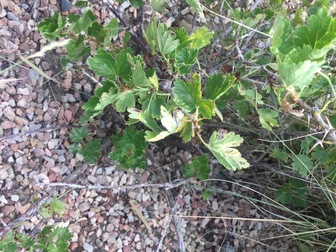Back to Tour: Medicinal Plants Tour
|
Ribes uva-crispa 'Red Jacket' Comanche Gooseberry; European Gooseberry Ribes uva-crispa 'Red Jacket' Comanche 951342*1 is no longer in the Denver Botanic Gardens plant collection. |
Denver Botanic Gardens
Gardens Navigator 
|
|
Accession Number: 951342*1 Map | |
| More about Ribes uva-crispa 'Red Jacket' Comanche | |
| TOUR DETAILS |
Medicinal uses: Yellow berries are known to have the richest flavor, and the wine made from them tastes like champagne. Red berries are considered the most acidic. The leaves of gooseberry can also be used in salads. Medicinally, the berries are considered a “cure-all” for inflammations. The green berries have been found to be a corrective of putrescent foods, such as goose. Jelly made from the red berries is valuable for its sedentary (relaxing), plethoric (widening the blood vessels), and bilious (excrete bile from the liver), properties. The berries also act as diuretics (increasing the passing of urine) and can help eliminate toxins from the body. They can also be used as invigorators for lack of appetite or exhaustion. Mythology/Folklore: There are many possible origins for the name “gooseberry.” One theory is that the 1719 definition of “goose” was slang for “fool,” signifying that only fools would cook gooseberry. The name “gooseberry” could have also been “goosebury,” an old English spelling which meant “a place where fools live.” It was an old wives’ tale told to children that newborns were found under gooseberry bushes. During the Middle Ages, gooseberry was considered a cure for the Bubonic plague. One common insult found centuries later was: “may the skin of a gooseberry cover all your enemies.” Another name for gooseberry is white currant, coming from the fruit resembling the dried currants of Greece. Our specimen of gooseberry (R. uva-crispa) has smooth berries, as opposed to its close relative R. glossularia, which has hairy berries. Medicinal recipe: Gooseberry vinegar: Crush the ripe berries with a fork and cover with the vinegar. Bring the mixture to a boil then simmer for 15 minutes. Strain off the fruit and discard. Return the ruby-red vinegar to the pan with the sugar and slowly bring to the boil, stirring occasionally. Allow cooling. Store in container in a dark and cool area. Culture: (from staff horticulturalist Sonya Anderson) “The gooseberries are similar [to chokeberry] but they can take more sun... but also do well in more shade. They don’t seem to require as much water on a consistent basis and can also tolerate periods of dryness without it negatively affecting their health and robustness.” |
| LOCATION GROUP | Birds & Bees |
| FAMILY NAME | Currant Family |
| FAMILY | Grossulariaceae |
| ACCESSION DATE |
August 17, 1995 (When this plant was acquired and registered in the database) |
| FRUIT COLOR | red |
| USDA HZ | 3 (Coldest Zone Where Hardy) |
| HABIT | Shrub |
| SOIL | Moderate moist, well-drained soil |
Location Map for 951342*1 Ribes uva-crispa 'Red Jacket' Comanche
Map Help
Flowering
When Ribes uva-crispa 'Red Jacket' Comanche has been observed flowering at Denver Botanic Gardens
 | ||||||||||||||||||||||||||||||||||||||||||||||||||||
| AVE. |  |
 |
 |
 |
 |
 |
 |
 |
 |
 |
 |
 |
 |
 |
 |
 |
 |
 |
 |
 |
 |
 |
 |
 |
 |
 |
 |
 |
 |
 |
 |
 |
 |
 |
 |
 |
 |
 |
 |
 |
 |
 |
 |
 |
 |
 |
 |
 |
 |
 |
 |
 |
| 2018 |  |
 |
 |
 |
 |
 |
 |
 |
 |
 |
 |
 |
 |
 |
 |
 |
 |
 |
 |
 |
 |
 |
 |
 |
 |
 |
 |
 |
 |
 |
 |
 |
 |
 |
 |
 |
 |
 |
 |
 |
 |
 |
 |
 |
 |
 |
 |
 |
 |
 |
 |
 |
| 2017 |  |
 |
 |
 |
 |
 |
 |
 |
 |
 |
 |
 |
 |
 |
 |
 |
 |
 |
 |
 |
 |
 |
 |
 |
 |
 |
 |
 |
 |
 |
 |
 |
 |
 |
 |
 |
 |
 |
 |
 |
 |
 |
 |
 |
 |
 |
 |
 |
 |
 |
 |
 |
| 2016 |  |
 |
 |
 |
 |
 |
 |
 |
 |
 |
 |
 |
 |
 |
 |
 |
 |
 |
 |
 |
 |
 |
 |
 |
 |
 |
 |
 |
 |
 |
 |
 |
 |
 |
 |
 |
 |
 |
 |
 |
 |
 |
 |
 |
 |
 |
 |
 |
 |
 |
 |
 |
| 2015 |  |
 |
 |
 |
 |
 |
 |
 |
 |
 |
 |
 |
 |
 |
 |
 |
 |
 |
 |
 |
 |
 |
 |
 |
 |
 |
 |
 |
 |
 |
 |
 |
 |
 |
 |
 |
 |
 |
 |
 |
 |
 |
 |
 |
 |
 |
 |
 |
 |
 |
 |
 |

© Denver Botanic Gardens, 1007 York Street, Denver, CO 80206
Photography © Denver Botanic Gardens

Powered by







 E-mail
E-mail